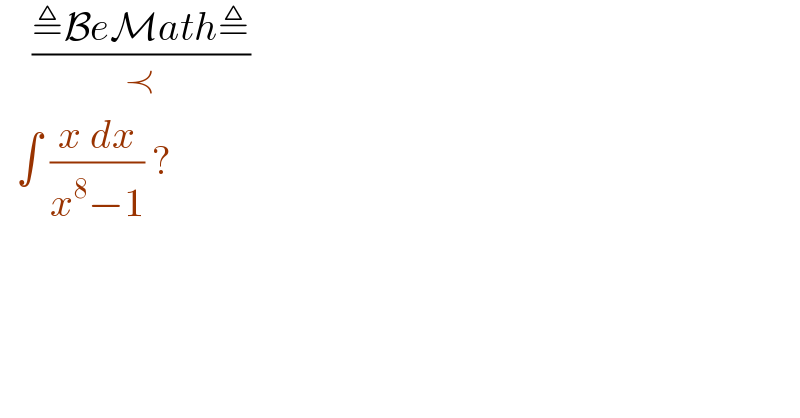Question Number 108073 by bemath last updated on 14/Aug/20

Answered by john santu last updated on 14/Aug/20
![((□JS⊡)/≢) I= ∫ ((x dx)/(x^8 −1)) set x^2 = z ⇒ 2x dx = dz I= (1/2)∫ (dz/(z^4 −1)) = (1/2)∫ (dz/((z^2 −1)(z^2 +1))) I=(1/4)∫[ (1/(z^2 −1))−(1/(z^2 +1))] dz I=(1/8)∫( (1/(z−1))−(1/(z+1)))dz−(1/4)tan^(−1) (z)+c I=(1/8)ln ∣((z−1)/(z+1))∣−(1/4)tan^(−1) (z)+c I=(1/8)ln ∣((x^2 −1)/(x^2 +1))∣−(1/4)tan^(−1) (x^2 )+c](https://www.tinkutara.com/question/Q108074.png)
Commented by bemath last updated on 14/Aug/20

Answered by malwaan last updated on 14/Aug/20
![∫(x/(x^8 −1))dx=(1/2)∫ ((d(x^2 ))/((x^2 )^4 −1)) y=x^2 ⇒(1/2)∫(dy/(y^4 −1)) =(1/2)∫[(dy/((y^2 +1)(y+1)(y−1)))]dy =(1/2)∫[((ay+b)/(y^2 +1))+(c/(y+1))+(d/(y−1))]dy y=1⇒4d=1⇒d=(1/4) y=−1⇒−4c=1⇒c=−(1/4) y=0⇒−b−c+d=1 ⇒b=(1/2)−1=−1 y=2⇒(2a−(1/2))(3)(1)+(−(1/4))(5)(1) +((1/4))(5)(3)=1⇒6a=0 ⇒a=0 ∴(1/2)∫[−(1/2)(1/(y^2 +1))−(1/4)(1/(y+1))+(1/4)(1/(y−1))]dy =−(1/4)tan^(−1) x^2 −(1/8)ln∣x^2 +1∣ +(1/8)ln∣x^2 −1∣+ C](https://www.tinkutara.com/question/Q108078.png)
Answered by mathmax by abdo last updated on 14/Aug/20
![complex method z^8 −1=0 ⇒z^8 =e^(i2kπ) ⇒z_k =e^((i2kπ)/8) =e^((ikπ)/4) k ∈[[0,7]] ⇒F(z) =(z/(z^8 −1)) =(z/(Π_(k=0) ^7 (z−z_k ))) =Σ_(k=0) ^7 (a_k /(z−z_k )) a_k =(z_k /(8z_k ^7 )) =(z_k ^2 /8) ⇒F(z) =(1/8)Σ_(k=0) ^7 (z_k ^2 /(z−z_k )) ⇒ ∫ F(z)dz =(1/8)Σ_(k=0) ^7 z_k ^2 ln(z−z_k ) +C](https://www.tinkutara.com/question/Q108091.png)
